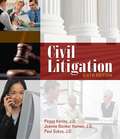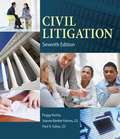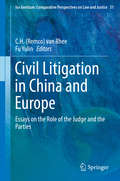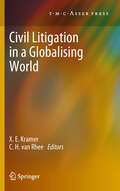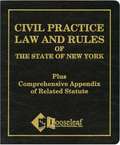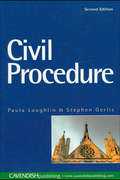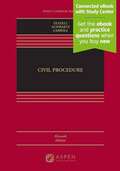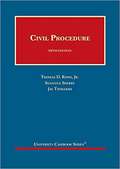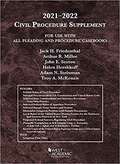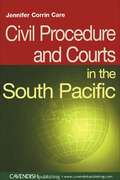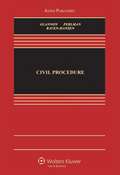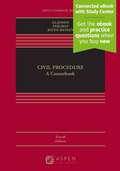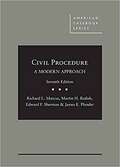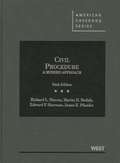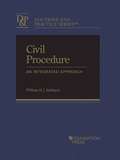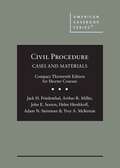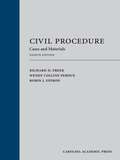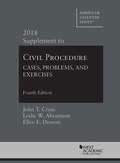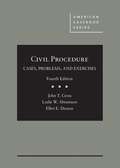- Table View
- List View
Civil Litigation (6th Edition)
by Paul A. Sukys Peggy Kerley Joanne Banker J. D. HamesCIVIL LITIGATION, 6th edition, enables readers to quickly grasp the principles of litigation practice through practical, hands-on instruction.
Civil Litigation Seventh Edition
by Paul A. Sukys Joanne Banker Hames Peggy KerleySucceed in your role as a paralegal with CIVIL LITIGATION, Seventh Edition. Practical, easy-to-understand, and thoroughly up-to-date, this proven book helps you grasp the details of today's litigation practice, covers the litigation process in a range of contexts, and demonstrates the relationship of litigation to other legal specialties. Each chapter includes exercises focusing on two cases, giving you the opportunity to work the cases from beginning to end, simulating an on-the-job experience. You'll also find sample documents (such as complaints, answers, interrogatories, and deposition summaries) that familiarize you with the documents you will encounter in the litigation law office.
Civil Litigation in China and Europe: Essays on the Role of the Judge and the Parties (Ius Gentium: Comparative Perspectives on Law and Justice #31)
by C. H. Remco Van Rhee Fu YulinThis volume addresses the role of the judge and the parties in civil litigation in mainland China, Hong Kong and various European jurisdictions. It provides an overview and an analysis of how these respective roles have been changed in order to cope with growing caseloads and quality demands. It also shows the different approaches chosen in the jurisdictions covered. Mainland China is introducing far-reaching reforms in its system of civil litigation. From an inquisitorial procedure, in which the parties play a relatively minor role, the country is changing to a more adversarial system with increased powers for the parties. At the same time, case management and the role of the judge as it is understood in mainland China remains different from case management and the role of the judge in Western countries, mainly as regards the limited powers of individual Chinese judges in this respect. Changes in China are justified by the ever-increasing case load of the Chinese courts and the consequent inability to deal with cases in an adequate manner, even though generally speaking Chinese courts still adjudicate civil cases within a relatively short time frame (this may, however, be problematic when viewed from the perspective of the quality of adjudication). Growing caseloads and quality concerns may also be observed in various European states and Hong Kong. In these jurisdictions the civil procedural systems have a relatively adversarial character and it is some of the adversarial features of the existing systems of procedure which are felt to be problematic. Therefore, the lawmakers have opted for increasing the powers of the judge, often making the judge and the parties mutually responsible for the proper conduct of civil cases. Starting from opposite directions, mainland China and the various European states and Hong Kong could meet half way in their reform attempts. This is, however, only possible if a proper understanding is fostered of the developments in these different parts of the World. Even though in both China and Europe the academic community and lawmakers are showing a keen interest in the relevant developments abroad, a study addressing the role of the judge and the parties in civil litigation in both China and Europe is still missing. This book aims to fill this gap in the existing literature.
Civil Litigation in a Globalising World
by C.H. van Rhee X. E. KramerGlobalization of legal traffic and the inherent necessity of having to litigate in foreign courts or to enforce judgments in other countries considerably complicate civil proceedings due to great differences in civil procedure. This may consequently jeopardize access to justice. This triggers the debate on the need for harmonization of civil procedure. In recent years, this debate has gained in importance because of new legislative and practical developments both at the European and the global level. This book discusses the globalization and harmonization of civil procedure from the angles of legal history, law and economics and (European) policy. Attention is paid to the interaction with private law and private international law, and European and global projects that aim at the harmonization of civil procedure or providing guidelines for fair and efficient adjudication. It further includes contributions that focus on globalization and harmonization of civil procedure from the viewpoint of eight different jurisdictions. This book is an unique combination of theory and practice and valuable for academic researchers in the area of civil procedure, private international law, international law as well as policy makers (national and EU), lawyers, judges and bailiffs.
Civil Litigation: Process And Procedures
by Thomas Goldman Alice HughesCivil Litigation: Process and Procedures, Third Edition, is designed to help students build the skill sets needed to succeed as members of today’s civil litigation teams. An Instructor’s Manual, PowerPoint lecture slides, and test bank are available for use with this text.
Civil Practice Law and Rules Plus Appendix (New York State)
by Looseleaf Law Publications Inc. StaffThe CPLR governs civil judicial proceedings in all courts of the state and before all judges. The appendix contains extracts of the N. Y. S. Constitution, Judiciary Law and the entire N. Y. C. Civil Court Act. Includes examples of related official forms. Revised - now includes NYCRR-PARTS 130 and 202.
Civil Procedure
by Paula Loughlin Stephen GerlisCivil Procedure provides an indispensable guide both to students of civil procedure at all levels as well as practitioners who regularly have to grapple with the CPR.
Civil Procedure (Aspen Casebook)
by Stephen C. Yeazell Maureen Carroll Joanna C. SchwartzCivil Procedure, 11th edition by Yeazell, Schwartz, and Carroll provides students with a working knowledge of the procedural system. In Civil Procedure, the authors employ a pedagogical style that offers flexible organization at a manageable length. The book introduces students to the procedural system and provides them with techniques of statutory analysis. <p><p>The included cases are factually interesting and do not involve substantive matters beyond the experience of first-year students. The problems following the cases present real-life issues. Finally, the book incorporates a number of dissenting opinions to dispel the notion that procedural disputes always present clear-cut issues.
Civil Procedure (Aspen Casebook)
by Stephen Yeazell Joanna SchwartzIn Civil Procedure, Tenth Edition, the authors employ a pedagogical style that offers flexible organization at a manageable length. The book gives students a working knowledge of the procedural system and introduces the techniques of statutory analysis. The cases selected are factually interesting and do not involve substantive matters beyond the experience of first-year students. The problems following the cases present real-life issues. Finally, the book incorporates a number of dissenting opinions to dispel the notion that most procedural disputes present clear-cut issues.
Civil Procedure (University Casebook)
by Suzanna Sherry Thomas Rowe Jr. Jay TidmarshCIVIL PROCEDURE FIFTH EDITION
Civil Procedure In Focus (Focus Casebook)
by Jeremy Counseller Eric PorterfieldCivil Procedure in Focus uses a combination of accessible explanatory text, cases, and other primary legal sources to teach civil procedure, and then provides opportunities to apply the law to multiple sets of facts in every chapter. Instead of using the “hide the ball” approach of traditional casebooks, selected cases illustrate key changes in the law and show how courts develop and apply doctrine. The approachable manner of this casebook provides a comfortable experiential environment that is essential to student success. With this new text, students apply concepts to real-world scenarios. Simply knowing the facts of a benchmark case is not enough: knowing how to apply the doctrine in a case to a different set of facts enhances a student’s ability to succeed after law school. Key Benefits: Case Previews and Post-Case Follow-Ups. To succeed, law students must know how to deconstruct and analyze cases. Case Previews highlight the legal concepts in a case before the student reads it. Post-Case Follow-Ups summarize the important points and go one step further—noting the significance of a case to current law as well as its later ramifications. Real Life Applications. Every case in a chapter is followed by Real Life Applications, which present a series of questions based on a scenario similar to the facts in the case. Real Life Applications challenge students to apply what they have learned and help prepare them for real-world practice. Professors can use Real Life Applications to spark class discussions or provide them as individual short-answer assignments. Applying the Concepts and Civil Procedure in Practice. These end-of-chapter exercises encourage students to synthesize the chapter material and apply relevant legal doctrine and code to real-world scenarios. Students can use these exercises for self-assessment or the professor can use them to promote class interaction.
Civil Procedure Supplement, For Use With All Pleading And Procedure Casebooks, 2021-2022
by Arthur Miller John Sexton Jack Friedenthal Helen Hershkoff Adam Steinman Troy McKenzieThis supplement is an up-to-date source for the Federal Rules of Civil Procedure and notes of advisory committees, plus other materials important for teaching Civil Procedure and advanced procedure courses, including selected provisions from the U.S. Constitution, U.S. Code and proposed legislation, state constitutions and state jurisdictional statutes, federal local rules, and Rules of Appellate Procedure. It also contains edited versions of recent cases of the Supreme Court of the United States, and provides materials for experiential learning that can be used even if teaching remotely, including a Flow Chart of a Civil Action, an Illustrative Litigation Problem with Sample Documents, and the complaints in Twombly, Iqbal, and Erickson v. Pardus.
Civil Procedure and Courts in the South Pacific
by Jennifer Corrin-CareThe book compares the main rules of procedure that govern the conduct of civil cases in countries of the South Pacific region and explains their practical application in the context of the courts in which they operate. The text focuses on the rules that apply and on the High Court (Civil Procedure) Rules of 1964, which apply in the superior courts of Kiribati, Tuvalu and Solomon Islands, and the rules that apply in the superior courts of the Fiji Islands, Samoa and Tonga. It also fully discusses the new rules of civil procedure that are currently being introduced in Vanatu. The text describes recent changes to regional civil procedure rules and suggests further reforms. Legislative and case law developments are also discussed. This book is designed for use by legal practitioners and anyone interested in civil procedure in the South Pacific region. It will also be of use to teachers and students of South Pacific civil procedure, both at degree level and in professional legal training programmes.
Civil Procedure: A Coursebook
by Joseph W. Glannon Peter Raven-Hansen Andrew M. PerlmanCasebooks generally present a series of cases followed by notes and questions, but the authors of this text saw the need for something different. They wrote this coursebook with features that are student-friendly. Each chapter begins with a summary, and each case begins with an introduction that includes questions to think about before reading the case. Notes and questions follow, but this work differs from others in that almost all the questions are answered. Ease of use and clarity shaped the design and organization of the book (e. g. short chapters, the use of fonts and borders to designate types of text, summaries of key concepts). Material is presented in chapters on subject matter jurisdiction, personal jurisdiction, venue, pleading, joinder and supplemental jurisdiction, discovery, choice of law, trial and pretrial, and after final judgment. Joseph W. Glannon and Andrew M. Perlman are affiliated with Suffolk U. , and Peter Raven-Hansen, with George Washington U. Annotation ©2011 Book News, Inc. , Portland, OR (booknews. com)
Civil Procedure: A Coursebook (Aspen Casebook)
by Joseph W. Glannon Peter Raven-Hansen Andrew M. PerlmanCivil Procedure: A Coursebook offers students doctrinal clarity without sacrificing analytical rigor or glossing over ambiguities. The book's accessibility, organization, and interior design support its innovative pedagogy making it the ideal text for any civil procedure course. <p><p>New to the Fourth Edition: <p>•New case treatment of personal jurisdiction in the Internet context. <p>•New cases and materials for affirmative defenses (qualified immunity), class certification (stop and frisk policy), summary judgment (police shooting/qualified immunity), and issue preclusion (official misconduct), helping students connect procedure to current social issues. <p>•New case treatment of proportionality in discovery. <p><p>Professors and student will benefit from: <p>•Nearly all questions asked are answered in the book <p>•Each chapter includes mini table of contents at beginning and summary of fundamentals at end <p>•Each case prefaced by accessible introduction <p>•Interior design and graphics support innovative pedagogy
Civil Procedure: A Modern Approach
by Richard Marcus Martin Redish Edward Sherman James PfanderSince it first appeared, this casebook has sought to capture the evolving challenges of civil procedure in a way that engages students and fosters critical judgment on the underlying policy issues. The authors have closely monitored the evolution of procedure over this time, and adapted the basic structure of the book to take account of those changes. <p><p> That evolution remains central to the seventh edition. The new edition retains the basic structure of the book, and a great deal of the existing superstructure of principal cases. It adds substantially revised text and note material to present contemporary issues in the context of those cases or new principal cases. The discovery chapter, for example, is infused with coverage of the 2015 rule amendments that have received so much attention. The personal jurisdiction chapter integrates the many recent Supreme Court decisions into the existing framework, conveying the developments that have occurred since the last edition appeared in 2013. <p><p> The new edition also offers new principal cases to examine and illustrate a number of issues. A new Rule 19 case on required parties presents the contemporary issues in a setting likely to be interesting to many students. A new Internet jurisdiction case involves online payday lending, an example of the fast-moving world of Internet-based commerce. A recent supplemental jurisdiction case enables students to work through the application of § 1367 in a setting that also involves appreciation of various joinder concepts. A new class-action case presents the challenges of consumer class actions. New Supreme Court and other principal cases address issues of subject matter jurisdiction and appellate jurisdiction. As reflects contemporary litigation, intellectual property cases are more prominent than in previous editions.
Civil Procedure: A Modern Approach (Sixth Edition)
by Martin H. Redish Richard L. Marcus Edward F. Sherman James E. PfanderThe sixth edition of this successful casebook continues the authors' commitment to providing professors and their students with the tools to address both foundational questions and cutting edge procedural issues in a practical way that is attuned to today's legal practice. It contains an expanded treatment of the increasingly important topic of pleading practice, and additional emphasis on electronic discovery issues. It also offers carefully edited versions of recent Supreme Court cases like Ashcroft v. Iqbal and J. McIntyre Machinery, Ltd. v. Nicastro, along with textual and note material to identify and highlight the critical issues. The class-action section contains presentations on Wal- Mart v. Dukes and the key issues raised by the Court's decisions on class-action waivers in arbitration clauses that are appropriate for first-year students. Throughout, the material has been updated and revised to focus on the critical issues of 21st century practice. As with prior editions, the authors will provide a thorough Teachers' Manual, which they will supplement with annual Teachers' Updates to keep teachers entirely up-to-date.
Civil Procedure: An Integrated Approach
by William HubbardCivil Procedure: An Integrated Approach (Doctrine and Practice Series) combines classic cases, contemporary lower-court gems, and an unmatched set of learning tools and teacher resources to make civil procedure accessible, relevant, and compelling. The hardcopy textbook is integrated with online flowcharts, quizzes, and videos that together give students of all learning styles a strong command of doctrine. It emphasizes the central role of lawyers in civil procedure, challenging students to discover the legal strategies and practical realities that make civil procedure the most important element in every litigator’s toolkit.
Civil Procedure: Cases and Materials (American Casebook)
by Helen Hershkoff Jack H. Friedenthal Arthur R. Miller John E. SextonThe Twelfth Edition of this very popular casebook provides a framework for studying the essential and cutting-edge issues of civil procedure in an accessible but rigorous way. The materials are designed to reinforce doctrinal understanding, to foster case reading skills, to encourage critical thinking about the real-world context of procedural decisions, and to help develop a sense of litigation strategy. <p><p> The casebook covers all of the major topics that a professor might wish to teach in a first-year course, and can easily be adapted for courses of one- or two-semesters, of different credit hours, and with varied practical or theoretical emphases. A supplement includes all updated Federal Rules, federal statutes and constitutional provisions pertinent to procedure, the pleadings in Twombly and Iqbal, a model case file, a litigation flow-chart, state materials, and other important teaching tools.
Civil Procedure: Cases and Materials, Compact Edition for Shorter Courses
by Arthur Miller John Sexton Jack Friedenthal Helen Hershkoff Adam Steinman Troy McKenzieThe Compact Thirteenth Edition of this very popular casebook is designed for three- or four-credit civil procedure courses. It provides a framework for studying the essential and cutting-edge issues of civil procedure in an accessible but rigorous way. The authors of the prior editions, Jack H. Friedenthal, Arthur R. Miller, John E. Sexton, and Helen Hershkoff, welcome two new authors to their team, Adam N. Steinman and Troy A. McKenzie. The new edition reflects the uniqueness, talents, and special expertise of these new authors, who individually and together bring tremendous new experiences and backgrounds to an author-team already known for its excellence and distinction. Adam N. Steinman, the University Research Professor of Law at the University of Alabama School of Law, is an award-winning teacher and scholar whose work has been cited in hundreds of articles and dozens of judicial opinions. He is an author on the Wright & Miller Federal and Practice & Procedure treatise and an elected member of the American Law Institute. He is also the co-organizer of the Unavailability Workshop for Civil Procedure and the co-editor of the Law Professor Blogs Network’s Civil Procedure & Federal Courts Blog. Prior to joining the University of Alabama faculty, he was a Professor of Law at Seton Hall University and the University of Cincinnati. His practice experience includes both complex civil litigation and public-interest appellate work. Troy A. McKenzie, Professor of Law at New York University School of Law, is an award-winning teacher and scholar who has taken an active role in the procedural rulemaking process.
Civil Procedure: Cases and Problems (Aspen Casebook)
by Toni M. Massaro Barbara Allen Babcock Norman W. Spaulding Myriam E. GillesCivil Procedure: Cases and Problems, Seventh Edition by Barbara Allen Babcock, Toni M. Massaro, Norman W. Spaulding, and new co-author Myriam Gilles (the #5 most cited civil procedure scholar in the country) is the ideal casebook for the modern Civil Procedure course. With lightly-edited cases, both canonical and contemporary, and engaging hypothetical problems, the Seventh Edition of Civil Procedure: Cases and Problems promotes student understanding of modern procedure, the adversary system and alternatives, the relationship between substance and procedure, and systemic problems in access to justice. <p><p>This casebook pioneered the “due process approach” to the study of procedure and is designed to create an inclusive learning environment, emphasizing the formative role of public interest litigation in modern procedural law and the voices of women and people of color in shaping the field in both practice and scholarship. It is the only major casebook on the market written by co-authors who together have received more than a dozen awards for excellence in teaching.
Civil Procedure: Cases, Materials, and Questions
by Richard D. Freer Wendy Collins Perdue Robin J. EffronThis innovative casebook is designed to be accessible to first year students while exposing them to the richness of the course. Each chapter begins with an ''Introduction and Integration'' section, which provides an overview and indicates how the materials relate to other topics. The authors explore the strategic and ethical issues faced by lawyers. The book features clear textual explication to set up consideration of cases. The seventh edition is wholly up-to-date, including the new discovery provisions that became effective December 1, 2015.
Civil Procedure: Cases, Problems and Exercises, 2018 Supplement (Fourth Edition) (American Casebook Series)
by Leslie W. Abramson John T. Cross Ellen E. DeasonThis supplement brings the principal text current with recent developments in the law and contains the Federal Rules of Civil Procedure with selected advisory committee notes and key provisions from the United States Code. It contains selections from the Federal Rules of Appellate Procedure, the Federal Rules of Evidence, and the United States Constitution that are useful for teaching Civil Procedure.
Civil Procedure: Cases, Problems, and Exercises (Fourth Edition) (American Casebook Series)
by Leslie W. Abramson John T. Cross Ellen E. Deason<p>This book differs from other Civil Procedure casebooks in several ways: <p> <li>A new feature uses a “modular” approach, enabling you to choose from “long” (paper) and “short” (electronic) versions of several chapters (including pleading, jurisdiction, and Erie). <li>Because of time constraints, several topics are in electronic formats only (including advanced joinder, alternate dispute resolution, and full-faith and credit). YOU have the option to select the depth of coverage for these topics. <li>Extensive problems and exercises encourage the student to read and apply the actual rule rather than a court's paraphrasing of that rule. <li>Extensive notes materials supplement the cases and problems. <li>The overall result = a very teachable book for you, as well as a useful long-term desk reference for your students.</li> </p>
